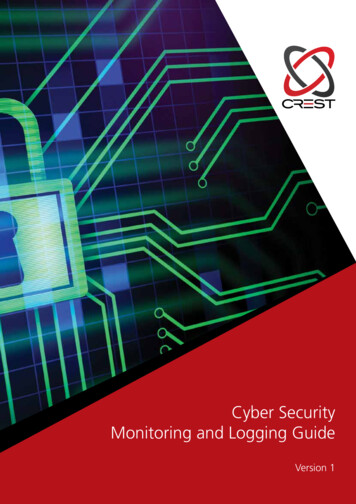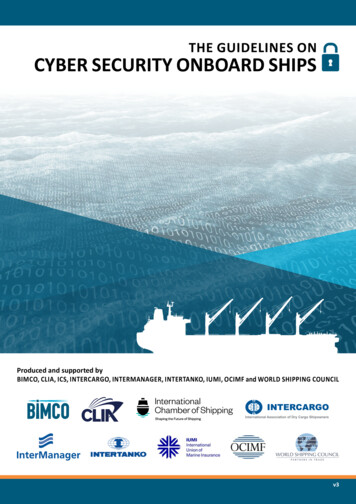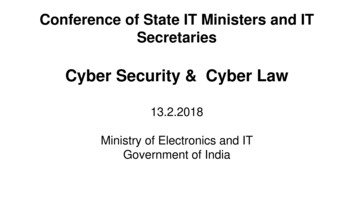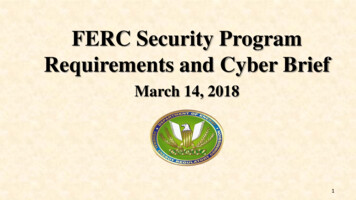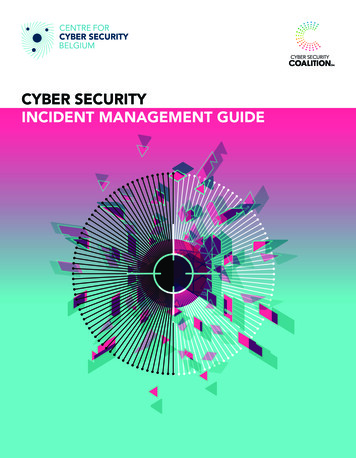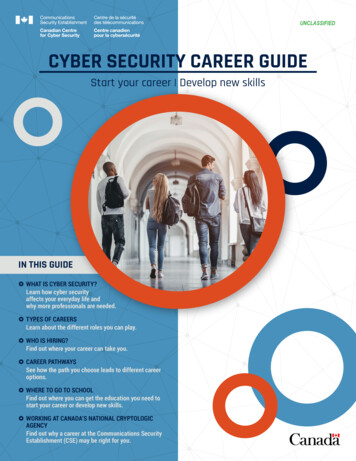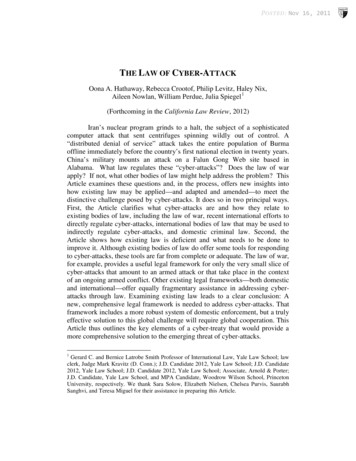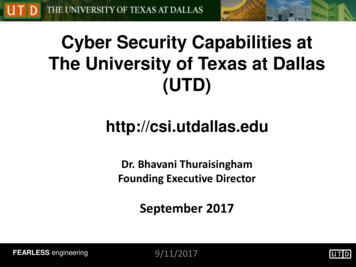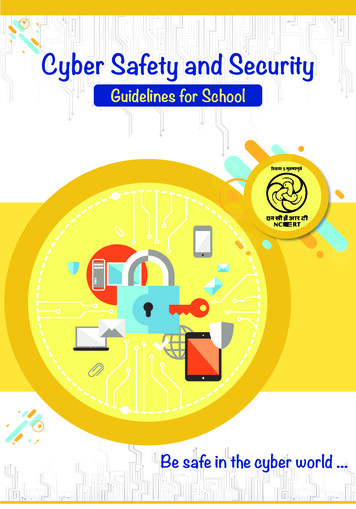
Transcription
Cyber Safety and SecurityGuidelines for SchoolBe safe in the cyber world .
DEVELOPMENT COMMITTEEChairpersonProf. Amarendra Behera, Joint Director, Central Institute of EducationalTechnology (CIET), NCERT, New Delhi.Member CoordinatorDr. Angel Rathnabai, Assistant Professor, Central Institute of EducationalTechnology (CIET), NCERT, New Delhi.MemberProf. M.U. Paily, RIE-NCERT, Mysuru, KarnatakaDr. Indu Kumar, Associate Professor and Head, DICT&TD, CIET - NCERT, New Delhi.Dr. Mohd. Mamur Ali, Assistant Professor, CIET- NCERT, New Delhi.Dr. Rejaul Karim Barbhuiya, Assistant Professor, DESM - NCERT, New Delhi.Dr. Ramanujam Meganathan, Associate Professor, DEL - NCERT, New Delhi.D. Varada M. Nikalje, Associate Professor, DEE - NCERT, New Delhi.Ms. Surbhi, Assistant Professor, CIET - NCERT, New Delhi.Mr. I L Narasimha Rao, Project Manager II, Center for Development of AdvancedComputing (CDAC), Hyderabad, Telangana.Ms. Sujata Mukherjee, Global Research and APAC Outreach Lead, Google India Pvt Ltd,Hyderabad, Telangana.Capt. Vineet Kumar, Founder and President, Cyber Peace Foundation, Ranchi, Jharkand.Ms. Chandni Agarwal (National ICT Awardee), Head, Department of Computer Science,Maharaja Agrasen Model School, New Delhi.Ms. Vineeta Garg, Head, Department of Computer Science, Shaheed Rajpal DAV PublicSchool, New Delhi.
Cybersafety is the safe and responsible use of information andcommunication technology. It is not just about keeping informationsafe and secure, but also about being responsible with thatinformation, being respectful of other people online, and practisinggood 'netiquette' (internet etiquette).As information infrastructure and Internet became biggerand morecomplex , it became critical to maintain systems functional and alerttosecurity issues.Thoughthesystemadministrationtasks have become easier in recent years, school administrators needto be more updated on the systems and network securityIn recent years, all systems are exposed to Internet; hence there isincreased challenge in maintaining and protecting them from theattackers.Schools play a key role in promoting internet safety. Schools areprimarily responsible for keeping systems/ computers/ networkdevices secure and functional. It is important to keep the informationas secure as we keep the systems and network devices in the organisation.
Index1Identify threat3vulnerability&assess risk exposure2Develop protectionProtectsensitive data5Educate yourstakeholders&detection measures4Respond toand recoverfromcyber securityincidents
Identify threatvulnerability&assess riskexposure.SPOOOOOSlow and sluggish behavior of the system.1Inexplicable disappearance of system screen while working.Unexpected pop ups or unusual error messages.Drainage of system battery life before expected period.Appearance of the infamous BSOD (Blue Screen of Death).Crashing of programs/ system.Inability to download updates.Navigation to new browser homepage, new toolbars and/or unwantedwebsites without any input.Circulation of strange messages from your email id to your friends.Appearance of new , unfamiliar icons on Desktop.Appearance of unusual message or programs which start automatically.Unfamiliar programs running in Task Manager.
2Develop protection&detection measuresInvest in a robust firewall.Have students and teachers create strong passwords.Have a password protocol that specifies strong password guidelines,frequent change of passwords, avoid reuse of old passwords.Use only verified open source or licensed software and operating systems.Ensure that computer systems and labs are accessed only by authorizedpersonnel.Discourage use of personal devices on the network, such as personal USBsor hard drives.Set up your computer for automatic software and operating system updates.Check that antivirus software in each system is regularly updated.Consider blocking of file extensions such as .bat, .cmd, .exe, .pif by usingcontent filtering software.
Develop protection&detection measures2Read the freeware and shareware license agreement to check if adwareand spyware are mentioned, before installing them on systems.Use encryption such as SSL or VPN for remote access to office or schoollab, through internet.Ensure that third-party vendors (who have contract with the school) havestrong security measures in place.Consider contracting with a trusted / verified third-party vendor to monitorthe security of your school’s network.Institute two or multi factor authentication for students, teachers andadministrators when they log on.Protect your Wi-Fi Connection with secure password, WEP encryption, etc.Encrypt the network traffic.Change the administrator’s password from the default password. If thewireless network does not have a default password, create one and use it toprotect the network.Disable file sharing on computers .Turn off the network during extended periods of non-use etc.Use "restricted mode", "safesearch", "supervised users" and other similarfilters and monitoring systems, so that no child can access harmful contentvia the school’s IT systems, and any concerns can be detected quickly.
3Protectsensitive dataDesign and implement information security and access controlprogrammes and policies by evaluating the storage (used/ unused),access, security and safety of sensitive information.Never store critical information in system’s C drive.Backup critical data (contact numbers, email IDs, aadhaar number etc.)in an off-site location.Establish safe reporting guidelines and escalation methods to protectthe identity of the person who reports the breach of security.
Respond to and recoverfromcyber securityincidents4Initial assessment: To ensure an appropriate response,it is essential that the response team find out:How the incident occurred ?Which IT and/or OT systems were affected and how ?The extent to which the commercial and/or operational data was affected ?To what extent any threat to IT and OT remains ?Recover systems and data: Following the initial assessment of thecyber incident, IT and OT systems and data should be cleaned,recovered and restored, as much as possible, to an operationalcondition by removing threats from the system and restoring the software.Investigate the incident: To understand the causes and consequencesof a cyber incident, an investigation should be undertaken by thecompany, with support from an external expert, if appropriate.The information from an investigation will play a significant role inpreventing a potential recurrence.Prevent re-occurrence: Complying with the outcome of the investigationmentioned above, any inadequacies in technical and/or proceduralprotection measures should be addressed, in accordance with the companyprocedures for implementation of corrective action.
5Stakeholders4Educate your stakeholders.Frame cyber safety rules as Do’s and Don’ts for the Schools.Orient school administrators with latest tools that can be used to monitorthe sites visited by the students/ teachers.Orient the stakeholders on cyber laws (http://cyberlawsindia.net/)Consult cyber security professionals to raise awareness levels about therisks in cyber space and their preventive measuresIntroduce courses/ lessons/ activities for students and teachers on majorcomponents of cyber security and safety.Advocate, model and teach safe, legal, and ethical use of digital informationand technology.Promote and model responsible social interactions related to the use oftechnology and informationCelebrate Safer Internet Day (February 5th) and conduct activities tocreate awareness through cyber clubsEstablish a relationship with a reputable cybersecurity firm/ organisation.Follow guidelines, policies and procedures to keep the school safe and securein cyberspace.
updateno toPassworddo notuse ingSystemSecurityOptionsUser to beOld idChat ScreenBe ScaredcleanUnknownPersonsfromMeetingin edit CardDetailsUser dAutoLockrecordswitch onuseCall backand do notType the URLReferralLinksCall fromWeired Numberdo ScarewareusesOnlinePredatorsdownloadapp irusCyber BullyingSpywareOnlineGroupsThreatsName nownPeople ebsitesCopyrightViolationE-mailAttachmentsdo notopennevervisitbrowser’scookies and cacheSpy Camerabeware ofwithBrowserPlugginsFriendshipin usingCYBERSECURITYInternet updateURLdo onsMAJOR FianyParentsSocial Mediausedo not romCyber CrimeFuncommittedforMoneySAFE PRACTICEuseInformation &DevicesAttentionupdatePiratedSoftware use ngeDestructionshould ation
For more details kendra.gov.inCentral Institute of Educational TechnologyNational Council of Educational Research and TrainingSri Aurbindo Marg, New Delhi-110016
Consult cyber security professionals to raise awareness levels about the risks in cyber space and their preventive measures Introduce courses/ lessons/ activities for students and teachers on major components of cyber security and safety. Advocate, model and teac

